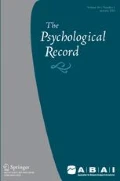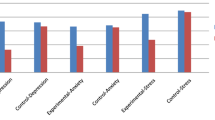Abstract
Eight chronic pain patients (6 males and 2 females) diagnosed as presenting reactive depression were randomly divided into two groups. Following individual assessment with the Minnesota Multiphasic Personality Inventory (MMPI), prescription of antidepressant medication, and electromyographic (EMG) measurement of forehead muscle tension, one group received EMG biofeedback-assisted relaxation training (BRT) and another group conventional medical treatment (TC). A final assessment was carried out on both (BRT and TC) groups immediately after 4 months of treatment. The BRT subjects showed significant reductions in EMG forehead muscle tension, T scores on the MMPI scale 2 (depression), and antidepressant medication following treatment compared to TC subjects. It is concluded that EMG biofeedback-assisted relaxation training is an effective biobehavioral treatment modality for reducing forehead muscle tension, elective antidepressant medication, and reactive depression of pain patients.
Similar content being viewed by others
References
ABRAMSON, L. Y., SELIGMAN, M. E. P., & TEASDALE, J. D. (1978). Learned helplessness in humans: Critique and reformulation. Journal of Abnormal Psychology, 87, 49–74.
ALARCON, R. D., & CORI, L. (1972). The precipitating event in depression. Journal of Nervous and Mental Disease, 155, 379–391.
BECK, A. T. (1970). Cognitive therapy; nature and relation to behavior therapy. Behavior Therapy, 7, 184–200.
BECK, A. T. (1976). Cognitive therapy and the emotional disorder. New York: International Universities Press.
BELLACK, A. S., HERSEN, M., & HIMMELHOCH, J. M. (1981). Social skills training, pharmacotherapy, and psychotherapy for unipolar depression. American Journal of Psychiatry, 138, 1562–1567.
BELLACK, A. S., HERSEN, M., & HIMMELHOCH, J. M. (1983). A comparison of social skills training, pharmacotherapy and psychotherapy for depression. Behavior Research Therapy, 21, 101–107.
BLANCHARD, E. B., ANDRASIK, F., APPELBAUM, K. A., EVANS, D. D., MYERS, P., & BARRON, K. D. (1986). Three studies of the psychological changes in chronic headache patients associated with biofeedback and relaxation therapy. Psychosomatic Medicine, 48, 73–83.
BRUDNY, J., GRYNBAUM, B. B., & KOREIN, J. (1974). Spasmodic torticollis: Treatment by feedback display of the EMG. Archives of Physical Medicine and Rehabilitation, 55, 403–408.
BUDZYNSKI, T. H. (1974). Bma audio cassette program. Warren, Michigan: Bio-Medical Instruments.
BUDZYNSKI, T., STOYVA, J. M., ADLER, C. S., & MULLANEY, D. J. (1973). Emg biofeedback and tension headache: A controlled outcome study. Psychosomatic Medicine, 35, 484–496.
BUSH, C., DITTO, B., & FEUERSTEIN, M. (1985). A controlled evaluation of paraspinal Emg biofeedback in the treatment of chronic low back pain. Health Psychology, 4, (4), 307–321.
COX, D., & THOMAS, D. (1981). Relationship between headaches and depression. Headache, 261–263.
DAHLSTROM, W. G., WELSH, G. S., & DALSTROM, L. E. (1972). An Mmpihandbook (Vol. 1): Clinical interpretation. Minneapolis: University of Minnesota Press.
DELK, J. L. (1977). Use of Emg biofeedback in behavioral treatment of an obsessive-phobic-depressive syndrome. Diseases of the Nervous System, 38, 938–939.
DEROGATIS, L., AVELLA, J., & LONG, D. (1977). Emg biofeedback in patients with chronic pain. Diseases of the Nervous System, 38, 505–509.
DONAT, D. C., & MCCULLOUGH, J. P. (1983). Psychophysiological determinants of depression at rest and in response to stress. Journal of Clinical Psychology, 39, 315–320.
FISHBEIN, D. (1985). Biofeedback applications to psychiatric disorder. The Psycholgoical Record, 35, 3–21..
FUTTERMAN, A. D., & SHAPIRO, D. (1986). A review of biofeedback for mental disorders. Hospital and Community Psychiatry, 37, 27–33.
HATHAWAY, S. R., & MEEHL, P. E. (1951). An atlas for the clincial use of the Mmpi, Minneapolis: University of Minnesota Press.
HENDLER, N., DEROGATIS, L., AVELLA, G., & LONG, D., (1977). EMG biofeedback in patients with chronic pain. Diseases of the Nervous System, 38, 505–509.
HERSEN, M., BELLACK, A. S., HIMMELHOCH, J. M., & THOSE, M. E. (1984). Effects of social skills training, amitriptyline, and psychotherapy in unipolar depressed women. Behavior Therapy, 15, 21–40.
KEEFE, F. J., SCHOPIRA, B., WILLIAMS, R. B., BROWN, C., & SURWIT, R. S. (1981). Emg-assisted relaxation training in the management of chronic low back pain. American Journal of Clinical Biofeedback, 4, 93–103.
KLEE, S., & MEYER, R. G. (1981). Alleviation of performance deficits of depression through thermal biofeedback training. Journal of Clinical Psychology, 37, 515–518.
KOTSES, H., & LAYH, J. P. (1981). Correlation between sample and integrated measures of Emg activity. American Journal of Clinical Biofeedback, 4, 117–120.
LEWINSOHN, P. M., WEINSTEIN, M. S., & ALPER, T. (1970). A behavioral approach to the group treatment of depressed persons: A methodological contribution. Journal of Clinical Psychology, 26, 525–532.
LIPOWSKI, Z. J. (1975). Psychiatry of somatic diseases: Epidemiology, pathogenesis, classification. Comparative Psychiatry, 16, 105–124.
LUBORSKY, L., SINGER, B., & LUBORSKY, L. (1975). Comparative studies of psychotherapies. Archives of General Psychiatry, 32, 995–1008.
MENDELS, J. (1970). Concepts of depression. New York: John Wiley.
MORRIS, J. B., & BECK, A. T. (1974). The efficacy of antidepressant drugs: A review of research (1958–1972). Archives of General Psychiatry, 30, 667–674.
PENISTON, E. G. (1986). EMG biofeedback-assisted desensitization treatment for Vietnam combat veterans with post-traumatic stress disorder. Clinical Bio feedback and Health, 9, (1), 35–41.
PENISTON, E. G., & HUGHES, R. B. (1986). Use of the Mmpi and Pat as evaluative measures of chronic pain. Clinical Biofeedback and Health, 9, (1), 15–21.
PENISTON, E. G., & KAO, P. C. (1985). Role of biofeedback-assisted relaxation training in muscle tension and analgesia. Clinical Biofeedback and Health, 8, (1), 163–169.
QUALLS, P. J., & SHEEHAN, P. N. (1981). Electromyograph biofeedback as a relaxation technique: A critical appraisal and reassessment. Psychological Bulletin, 90, 21–42.
REISINGER, J. J. (1972). The treatment of “anxiety-depression” via positive reinforcement and response cost. Journal of Applied Behavior Analysis, 5, 125–130.
ROBINSON, J. D., & LEWINSOHN, P. M. (1973). Experimental analysis of a technique based on the Premack Principle changing verbal behavior of depressed individuals. Psychological Reports 32, 199–210.
ROSENHAN, D. L., & SELIGMAN, M. E. P. (1984). Abnormal psychology. New York: Norton.
ROTH, D., BIELSKI, R., JONES, M., PARKER, W., & OSBORN, G. (1982). A comparison of self-control therapy and combined self-control therapy and antidepressant medication in the treatment of depression. Behavior Therapy, 13, 133–144.
RUSH, A. J., & BECK. A. T. (1977, April). Cognitive approaches to depression: Empirical basis for theory and therapy. Paper presented at the Loyola University Symposium: New directions in the understanding and treatment of depression, Chicago.
RYBSTEIN-BLINCHNIK, E. (1979). The effects of different cognitive strategies on chronic pain experience. Journal of Behavioral Medicine, 2, 93–102.
SARGENT, J. D., GREEN, E. E., & WALTER, E. D. (1973). Preliminary report on the use of autogenic feedback training in the treatment of migraine and tension headaches. Psychosomatic Medicine, 35, 129–135.
SCHWAB, J. J., BROWN, G. M., & HOLZER, C. E. (1967). Sociocultural aspects of depression in medical inpatients. Archives of General Psychiatry, 17, 533–541.
SELIGMAN, M. E. P. (1972). Learned helplessness. Annual Review of Medicine, 23, 407–412.
SELIGMAN, M. E. P. (1975a). Depression and learned helplessness. In R. J. Friedman & M. M. Katz (Eds.), The psychology of depression: Contemporary theory and research. Washington: Winston-Wiley.
SELIGMAN, M. E. P. (1975b). Helplessness: On depression, development, and death. San Francisco: W. H. Freeman.
SELIGMAN, M. E. P., KLEIN, D. C., & MILLERS, W. R. (1975). Depression. In H. Leitenberg (Ed.), Handbook of behavior modification and behavior therapy. Englewood Cliffs, NJ: Prentice-Hall.
SOVAK, N., KUNZEL, M., STERNBACH, R. A., & DALESSIO, D. (1981). Mechanism of the biofeedback therapy of migraine: Volitional manipulation of the psychophysiological background. Headache, 21, 261–263.
STERN, G. S., BERRENBERG, J. L., WINN, D., & DUBOIS, P. L. (1978). Perceived control: Contingent and noncontingent feedback in pulse-rate change and reduction in depressive cognitions. Bio feedback and Self Regulation, 3, 277–285.
STERNBACH, R. (1974). Pain patients—Traits and treatment. New York: Academic Press.
TASTO, D. L., & CHESNEY, M. A. (1974). Muscle relaxation treatment for primary dysmenorrhea. Behavior Therapy, 5, 668–672.
TURK, D. C., MEICHENBAUM, D. H., & BERMAN, W. H. (1979). Application of biofeedback for the regulation of pain: A critical review. Psychological Bulletin, 86, 1322–1338.
WEISS, T., & ENGEL, B. T. (1971). Operant conditioning of heart rate in patients with premature ventricular contractions. Psychosomatic Medicine, 33, 301–321.
WENTWORTH-ROHR, I. (1984). Symptom reduction through clinical biofeedback. New York: Human Sciences Press.
WHITE, L., & TURSKY, B. (1982). Clinical biofeedback: Efficacy and mechanisms. New York: Guilford Press.
WIENER, D. N., & HARMON, L. R. (1946). Subtle and obvious keys for the Mmpi: Their development. Advisement Bulletin No. 16, Regional Veterans Administration Office, Minneapolis.
WOLPE, J. (1971). Neurotic depression: Experimental analog, clinical syndromes, and treatment. American Journal of Psychotherapy, 25, 362–368.
WOLPE, J., & LAZARUS, A. (1966). Behavior therapy techniques. New York: Pergamon Press.
Author information
Authors and Affiliations
Additional information
Special thanks to Fort Lyon VA Medical Center for support of the study and to M. Sanchez for his assistance.
Rights and permissions
About this article
Cite this article
Peniston, E.G., Hughes, R.B. & Kulkosky, P.J. EMG Biofeedback-Assisted Relaxation Training in the Treatment of Reactive Depression in Chronic Pain Patients. Psychol Rec 36, 471–482 (1986). https://doi.org/10.1007/BF03394967
Published:
Issue Date:
DOI: https://doi.org/10.1007/BF03394967




